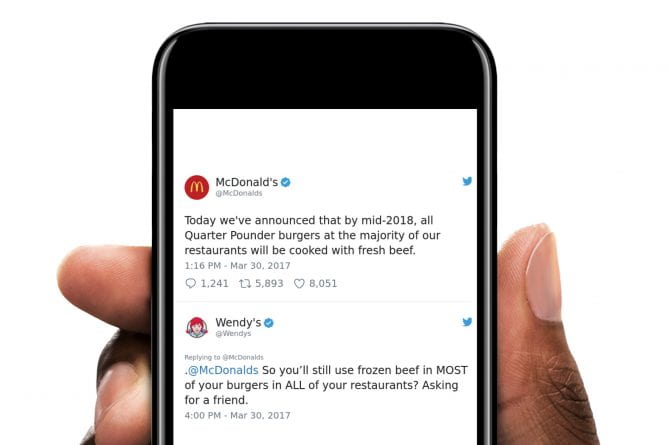What happens when brands get snarky with each other on social media?
By Jenna Harrity
When it comes to social media marketing, every brand strives to have a distinct voice. And some have become well known for their witty social media personalities.
One of these is Wendy’s, which has 3.6 million followers on Twitter and regularly produces sassy, viral tweets, often poking fun at competitors. It once called the McDonald’s food truck a garbage truck and routinely criticizes McDonald’s for using frozen burger patties instead of fresh beef.
Previous studies have found that tone must match the brand for its marketing efforts to be successful. For Wendy’s, its scathing wit has been a hit. But, in a broader survey, does this banter make the provoking brand more likable or does it hurt public sentiment?
Associate professor of marketing Veronica Thomas, Ph.D., recently put this question to the test. Thomas and her colleague, Kendra Fowler from Youngstown State University, noticed a gap in research concerning consumer response to sarcastic exchanges between two brands on social media.
“Consumers don’t like a nice response to an initial sarcastic tone. It’s boring.”
Their research is novel in its field since other research has focused on analyzing a single brand.
Thomas’ and Fowler’s results surprised them.
“I thought that using a mid-level humor would be preferred by consumers over a neutral response,” admits Thomas.
In their study, Thomas and Fowler asked survey participants to rate their feelings toward two brands by their responses to a consumer tweet: “New to town and need a birthday cake for a party. How do @TopFrost and @TastyBakes compare?”
@TopFrost and @TastyBakes are bakeries invented for the purpose of the survey to eliminate the risk of bias toward real brands.
The participants were shown a chain of tweets replying to the original consumer’s question. The chain included an initial reply from @TopFrost that was neutral, sarcastic or aggressive. The second reply was from @TastyBakes, responding to @TopFrost in a neutral, sarcastic or aggressive tone.
Participants preferred when @TopFrost’s initial reply was neutral, “@TopFrost is our top choice!” over the more sarcastic response, “They don’t.”
Further, participants’ feelings toward @TastyBakes depended on @TopFrost’s tone.
“Consumers really liked it when @TopFrost was sarcastic and @TastyBakes responded in-turn. Consumers don’t like a nice response to an initial sarcastic tone. It’s boring,” said Thomas.
“If the initial brand is aggressive or rude, you have free reign as the responding brand to answer nicely, satirically or aggressively back, and consumers will like you, regardless,” she added.
Basically, fight fire with fire.
The title for this research is spot on: “An Eye for an Eye,” indeed.
Aside from pioneering dyadic brand relationship research, Thomas and Fowler are also the first to recommend social media responses backed by research.
With this research, they compiled a social media banter guidebook. If you want to engage with another brand on social media, Thomas recommends to first, “play it safe and nice.” The guidebook also breaks down how brands can respond to an initiator using each of the three tones.
If your brand is responding to a satirical initiator, Thomas and Fowler recommend responding with a similar tone.
“Don’t be afraid to have some good fun,” said Thomas. “Consumers appear to appreciate and reward brands that engage in humorous banter.”


